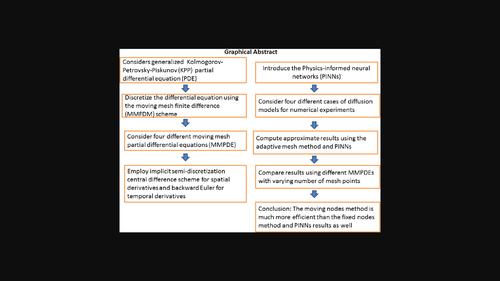当前位置:
X-MOL 学术
›
Int. J. Numer. Methods Fluids
›
论文详情
Our official English website, www.x-mol.net, welcomes your feedback! (Note: you will need to create a separate account there.)
A comparative investigation of a time-dependent mesh method and physics-informed neural networks to analyze the generalized Kolmogorov–Petrovsky–Piskunov equation
International Journal for Numerical Methods in Fluids ( IF 1.8 ) Pub Date : 2024-01-18 , DOI: 10.1002/fld.5259 Saad Sultan 1 , Zhengce Zhang 1
International Journal for Numerical Methods in Fluids ( IF 1.8 ) Pub Date : 2024-01-18 , DOI: 10.1002/fld.5259 Saad Sultan 1 , Zhengce Zhang 1
Affiliation

|
The Kolmogorov–Petrovsky–Piskunov (KPP) partial differential equation (PDE) is solved in this article using the moving mesh finite difference technique (MMFDM) in conjunction with physics-informed neural networks (PINNs). We construct a time-dependent mesh to obtain approximate solutions for the KPP problem. The temporal derivative is discretized using a backward Euler, while the spatial derivatives are discretized using a central implicit difference scheme. Depending on the error measure, several moving mesh partial differential equations (MMPDEs) are employed along the arc-length and curvature mesh density functions (MDF). The proposed strategy has been suggested to yield remarkably precise and consistent results. To find the approximate solution, we additionally employ physics-informed neural networks (PINNs) to compare the outcomes of the adaptive moving mesh approach. It has been observed that solutions obtained using the moving mesh method (MMM) are sufficiently accurate, and the absolute error is also much lower than the PINNs.
中文翻译:

时间相关网格方法和物理信息神经网络的比较研究,用于分析广义 Kolmogorov-Petrovsky-Piskunov 方程
本文使用移动网格有限差分技术 (MMFDM) 结合物理信息神经网络 (PINN) 来求解 Kolmogorov-Petrovsky-Piskunov (KPP) 偏微分方程 (PDE)。我们构建一个与时间相关的网格来获得 KPP 问题的近似解。时间导数使用后向欧拉离散化,而空间导数使用中心隐式差分方案离散化。根据误差测量,沿弧长和曲率网格密度函数 (MDF) 采用多个移动网格偏微分方程 (MMPDE)。建议所提出的策略可以产生非常精确和一致的结果。为了找到近似解,我们还使用物理信息神经网络(PINN)来比较自适应移动网格方法的结果。据观察,使用移动网格法 (MMM) 获得的解足够准确,并且绝对误差也远低于 PINN。
更新日期:2024-01-18
中文翻译:

时间相关网格方法和物理信息神经网络的比较研究,用于分析广义 Kolmogorov-Petrovsky-Piskunov 方程
本文使用移动网格有限差分技术 (MMFDM) 结合物理信息神经网络 (PINN) 来求解 Kolmogorov-Petrovsky-Piskunov (KPP) 偏微分方程 (PDE)。我们构建一个与时间相关的网格来获得 KPP 问题的近似解。时间导数使用后向欧拉离散化,而空间导数使用中心隐式差分方案离散化。根据误差测量,沿弧长和曲率网格密度函数 (MDF) 采用多个移动网格偏微分方程 (MMPDE)。建议所提出的策略可以产生非常精确和一致的结果。为了找到近似解,我们还使用物理信息神经网络(PINN)来比较自适应移动网格方法的结果。据观察,使用移动网格法 (MMM) 获得的解足够准确,并且绝对误差也远低于 PINN。



























 京公网安备 11010802027423号
京公网安备 11010802027423号